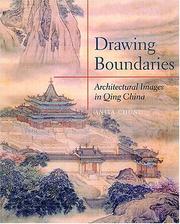| Listing 1 - 4 of 4 |
Sort by
|

ISBN: 0824826639 Year: 2004 Publisher: Honolulu University of Hawai'i Press
Abstract | Keywords | Export | Availability | Bookmark
 Loading...
Loading...Choose an application
- Reference Manager
- EndNote
- RefWorks (Direct export to RefWorks)
Architectural drawing --- Architecture in art --- Buildings in art --- Painting, Chinese
Book
ISBN: 0824862260 Year: 2004 Publisher: Honolulu : University of Hawaii Press,
Abstract | Keywords | Export | Availability | Bookmark
 Loading...
Loading...Choose an application
- Reference Manager
- EndNote
- RefWorks (Direct export to RefWorks)
Qing China (1644-1912) witnessed a resurgence in architectural painting, a traditional subject category known as jiehua, or boundary painting. Drawing Boundaries concerns itself with the symbolic implications of this impressive and little studied reflorescence. Beginning with a concise and well-illustrated history of the evolution of the tradition, this exciting new study reveals how these images were deployed in the Manchu (Qing) imperial court to define political, social, or cultural boundaries. Characterized by grand conception and regal splendor, the paintings served to enhance the imperial authority of rulers and, to a segment of the elite, to advertise social status. Drawing Boundaries thus speaks to both issues of painting and architectural style and the discourse of powerful cultural forms. In addition to the analysis of how the style of image construction suggests these political and social motivations, the book identifies another aspect of traditional architectural representation unique to the Qing: the use of architectural representation to render form and space. Anita Chung makes the fascinating observation that these renderings create an overwhelming sense of "being there," a characteristic, she argues, that underscores the Qing concern for the substance of things-a sensibility toward the physical world characteristic of the period and emblematic of a new worldview.
Architectural drawing --- Painting, Chinese --- Buildings in art. --- Architecture in art.
Book
ISBN: 9780824862268 Year: 2004 Publisher: Honolulu
Abstract | Keywords | Export | Availability | Bookmark
 Loading...
Loading...Choose an application
- Reference Manager
- EndNote
- RefWorks (Direct export to RefWorks)
Book
ISBN: 9780300206074 Year: 2015 Publisher: New Haven, CT ; London Yale University Press
Abstract | Keywords | Export | Availability | Bookmark
 Loading...
Loading...Choose an application
- Reference Manager
- EndNote
- RefWorks (Direct export to RefWorks)
| Listing 1 - 4 of 4 |
Sort by
|

 Search
Search Feedback
Feedback About UniCat
About UniCat  Help
Help News
News